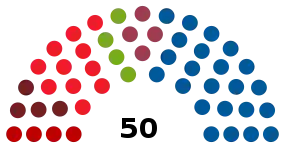2003 Navarrese regional election
The 2003 Navarrese regional election was held on Sunday, 25 May 2003, to elect the 6th Parliament of the Chartered Community of Navarre. All 50 seats in the Parliament were up for election. The election was held simultaneously with regional elections in twelve other autonomous communities and local elections all throughout Spain.
| |||||||||||||||||||||||||||||||||||||||||||||||||||||||||||||||||||||||||||||||||||||
All 50 seats in the Parliament of Navarre 26 seats needed for a majority | |||||||||||||||||||||||||||||||||||||||||||||||||||||||||||||||||||||||||||||||||||||
|---|---|---|---|---|---|---|---|---|---|---|---|---|---|---|---|---|---|---|---|---|---|---|---|---|---|---|---|---|---|---|---|---|---|---|---|---|---|---|---|---|---|---|---|---|---|---|---|---|---|---|---|---|---|---|---|---|---|---|---|---|---|---|---|---|---|---|---|---|---|---|---|---|---|---|---|---|---|---|---|---|---|---|---|---|---|
| Opinion polls | |||||||||||||||||||||||||||||||||||||||||||||||||||||||||||||||||||||||||||||||||||||
| Registered | 464,826 | ||||||||||||||||||||||||||||||||||||||||||||||||||||||||||||||||||||||||||||||||||||
| Turnout | 328,609 (70.7%) | ||||||||||||||||||||||||||||||||||||||||||||||||||||||||||||||||||||||||||||||||||||
| |||||||||||||||||||||||||||||||||||||||||||||||||||||||||||||||||||||||||||||||||||||
| |||||||||||||||||||||||||||||||||||||||||||||||||||||||||||||||||||||||||||||||||||||
Overview
Electoral system
The Parliament of Navarre was the devolved, unicameral legislature of the Chartered Community of Navarre, having legislative power in regional matters as defined by the Spanish Constitution and the Reintegration and Enhancement of the Foral Regime of Navarre Law, as well as the ability to vote confidence in or withdraw it from a President of the Foral Deputation. Voting was on the basis of universal suffrage, which comprised all nationals over eighteen, registered in Navarre and in full enjoyment of their political rights.
The 50 members of the Parliament of Navarre were elected using the D'Hondt method and a closed list proportional representation, with a threshold of 3 percent of valid votes—which included blank ballots—being applied regionally. Parties not reaching the threshold were not taken into consideration for seat distribution.
The electoral law provided that parties, federations, coalitions and groupings of electors were allowed to present lists of candidates. However, groupings of electors were required to secure the signature of at least 1 percent of the electors registered in Navarre. Electors were barred from signing for more than one list of candidates. Concurrently, parties and federations intending to enter in coalition to take part jointly at an election were required to inform the relevant Electoral Commission within ten days of the election being called.[3][4]
Election date
The term of the Parliament of Navarre expired four years after the date of its previous election. Elections to the Parliament were fixed for the fourth Sunday of May every four years. The previous election was held on 13 June 1999, setting the election date for the Parliament on Sunday, 25 May 2003.[3][4]
After legal amendments in 2001, the President of the Foral Deputation was granted the prerogative to dissolve the Parliament of Navarre and call a snap election, provided that no motion of no confidence was in process, no nationwide election was due and some time requirements were met: namely, that dissolution did not occur either during the first legislative session or within the legislature's last year ahead of its scheduled expiry, nor before one year had elapsed since a previous dissolution under this procedure. In the event of an investiture process failing to elect a regional President within a thirty-day period from the first ballot, the Parliament was to be automatically dissolved and a fresh election called. Any snap election held as a result of these circumstances would not alter the period to the next ordinary election, with elected deputies merely serving out what remained of their four-year terms.
Opinion polls
The table below lists voting intention estimates in reverse chronological order, showing the most recent first and using the dates when the survey fieldwork was done, as opposed to the date of publication. Where the fieldwork dates are unknown, the date of publication is given instead. The highest percentage figure in each polling survey is displayed with its background shaded in the leading party's colour. If a tie ensues, this is applied to the figures with the highest percentages. The "Lead" column on the right shows the percentage-point difference between the parties with the highest percentages in a given poll. When available, seat projections are also displayed below the voting estimates in a smaller font. 26 seats were required for an absolute majority in the Parliament of Navarre.
- Color key:
Exit poll
| Polling firm/Commissioner | Fieldwork date | Sample size | Turnout | CDN | PNV | Lead | |||||||
|---|---|---|---|---|---|---|---|---|---|---|---|---|---|
| 2003 regional election | 25 May 2003 | N/A | 70.7 | 41.5 23 |
21.2 11 |
– | 8.8 4 |
7.7 4 |
7.4 4 |
[lower-alpha 1] | 2.6 0 |
7.8 4 |
20.3 |
| Sigma Dos/Antena 3[p 1] | 25 May 2003 | ? | ? | ? 24/25 |
? 12/13 |
– | ? 5 |
? 4 |
? 4 |
[lower-alpha 1] | – | – | ? |
| Ipsos–Eco/RTVE[p 2] | 25 May 2003 | ? | ? | ? 24 |
? 11/13 |
– | ? 4/5 |
– | – | [lower-alpha 1] | – | – | ? |
| CIES/Diario de Navarra[p 3][p 4] | 7–13 May 2003 | 1,600 | 65 | 43.6 22/24 |
25.5 12/14 |
– | 8.1 4/5 |
7.5 3/4 |
6.7 3/4 |
[lower-alpha 1] | 1.5 0 |
6.5 3 |
18.1 |
| CIS[p 5][p 6] | 22 Mar–28 Apr 2003 | 829 | 67.1 | 38.3 24 |
20.7 13 |
– | 8.6 5 |
6.3 3 |
8.4 5 |
[lower-alpha 1] | – | – | 17.6 |
| CIES/Diario de Navarra[p 7] | 17–28 Feb 2003 | 1,212 | 65 | 40.6 22 |
23.7 12 |
10.4 5 |
6.4 3 |
5.7 3 |
7.4 4 |
[lower-alpha 1] | 2.1 0 |
3.2 1 |
16.9 |
| n@vcomtel/Parliament of Navarre[p 8][p 9] | 21–27 Oct 2002 | 1,600 | ? | 41.2 22/23 |
22.5 11/12 |
13.0 6/7 |
7.5 3/4 |
5.6 2/3 |
4.9 2 |
[lower-alpha 1] | 1.1 0 |
3.3 1 |
18.7 |
| CIS[p 10][p 11][p 12] | 9 Sep–9 Oct 2002 | 443 | 67.3 | 43.9 25 |
21.0 12 |
8.7 4 |
8.6 4 |
4.8 2 |
5.1 2 |
3.3 1 |
– | – | 22.9 |
| CIES/Parliament of Navarre[p 13][p 14] | 24 Sep–2 Oct 2001 | 1,300 | 68 | 44.2 23/24 |
24.0 12/13 |
8.1 4 |
6.6 3 |
5.4 2 |
6.4 3 |
[lower-alpha 1] | 1.2 0 |
3.8 2 |
20.2 |
| 2000 general election | 12 Mar 2000 | N/A | 66.1 | 49.9 29 |
27.3 15 |
– | 7.6 4 |
2.9 0 |
6.8 2 |
2.2 0 |
– | – | 22.6 |
| 1999 regional election | 13 Jun 1999 | N/A | 66.2 | 41.4 22 |
20.3 11 |
15.6 8 |
6.9 3 |
6.9 3 |
5.4 3 |
[lower-alpha 1] | [lower-alpha 2] | – | 21.1 |
Results
 | ||||||
| Parties and coalitions | Popular vote | Seats | ||||
|---|---|---|---|---|---|---|
| Votes | % | ±pp | Total | +/− | ||
| Navarrese People's Union (UPN) | 127,460 | 41.48 | +0.11 | 23 | +1 | |
| Socialist Party of Navarre (PSN–PSOE) | 65,003 | 21.15 | +0.87 | 11 | ±0 | |
| United Left of Navarre (IUN/NEB) | 26,962 | 8.77 | +1.89 | 4 | +1 | |
| Aralar (Aralar) | 24,068 | 7.83 | New | 4 | +4 | |
| Convergence of Democrats of Navarre (CDN) | 23,516 | 7.65 | +0.79 | 4 | +1 | |
| Basque Solidarity–Basque Nationalist Party (EA–PNV) | 22,824 | 7.43 | +1.99 | 4 | +1 | |
| Assembly (Batzarre) | 7,873 | 2.56 | New | 0 | ±0 | |
| Humanist Party (PH) | 1,290 | 0.42 | New | 0 | ±0 | |
| Carlist Party (EKA–PC) | 1,017 | 0.33 | +0.04 | 0 | ±0 | |
| Basque Citizens (EH) | n/a | n/a | –15.58 | 0 | –8 | |
| Blank ballots | 7,304 | 2.38 | +0.03 | |||
| Total | 307,317 | 50 | ±0 | |||
| Valid votes | 307,317 | 93.52 | –5.65 | |||
| Invalid votes | 21,292 | 6.48 | +5.65 | |||
| Votes cast / turnout | 328,609 | 70.70 | +4.45 | |||
| Abstentions | 136,217 | 29.30 | –4.45 | |||
| Registered voters | 464,826 | |||||
| Sources[5][6] | ||||||
Aftermath
After legal amendments in 2001, investiture processes to elect the President of Navarre required for an absolute majority—more than half the votes cast—to be obtained in the first ballot. If unsuccessful, a new ballot would be held 24 hours later requiring only of a simple majority—more affirmative than negative votes—to succeed. If such majorities were not achieved, successive candidate proposals would be processed under the same procedure. In the event of the investiture process failing to elect a regional President within a thirty-day period from the first ballot, the Parliament would be automatically dissolved and a snap election called.
| Investiture Miguel Sanz (UPN) | ||
| Ballot → | 26 June 2003 | |
|---|---|---|
| Required majority → | 26 out of 50 | |
27 / 50 | ||
23 / 50 | ||
| Abstentions | 0 / 50 | |
| Absentees | 0 / 50 | |
| Sources[6] | ||
References
- Opinion poll sources
- "El sondeo de Sigma Dos determina una lucha codo a codo entre populares y socialistas en Madrid". ABC Sevilla (in Spanish). 25 May 2003. Archived from the original on 25 May 2019. Retrieved 19 May 2019.
- "Sondeo a pie de urna de Ipsos Eco Consulting para TVE". ABC Sevilla (in Spanish). 25 May 2003. Archived from the original on 7 December 2017. Retrieved 24 June 2018.
- "UPN (22-24) y PSN (12-14) suben, Aralar entra con 3 y CDN (3-4) será clave para el Gobierno". Diario de Navarra (in Spanish). 18 May 2003.
- "Sondeos electorales CIES" (PDF). CIES (in Spanish). 22 May 2011.
- "Preelectoral elecciones autonómicas, 2003. Comunidad Foral de Navarra (Estudio nº 2495. Marzo-Abril 2003)" (PDF). CIS (in Spanish). 17 May 2003.
- "La guerra pasa factura electoral al PP". La Vanguardia (in Spanish). 18 May 2003.
- "UPN mantiene 22 parlamentarios y el PSN sube de 11 a 12 escaños". Diario de Navarra (in Spanish). 16 March 2003.
- "Informe de la Actualidad en Navarra. Noviembre, 2002" (PDF). n@vcomtel (in Spanish). 12 November 2002.
- "Una encuesta del Parlamento navarro concluye que Batasuna recupera apoyos". El País (in Spanish). 13 November 2002.
- "Instituciones y autonomías, II. Comunidad Foral de Navarra (Estudio nº 2455. Septiembre-Octubre 2002)". CIS (in Spanish). 19 November 2002.
- "El PP, partido más votado en diez Comunidades Autónomas" (PDF). El Mundo (in Spanish). 19 November 2002.
- "El PP ganaría las autonómicas en diez Comunidades y el PSOE en cuatro, según el CIS". ABC (in Spanish). 20 November 2002.
- "UPN, cerca de la mayoría absoluta y Batasuna pierde 4 escaños". Diario de Navarra (in Spanish). 17 October 2001.
- "Estudio sobre la Actualidad de Navarra. Octubre, 2001" (PDF). CIES (in Spanish). 16 October 2001.
- Other
- "General Electoral System Organic Law of 1985". Organic Law No. 5 of 19 June 1985. Official State Gazette (in Spanish). Retrieved 28 December 2016.
- "Representation of the people Institutional Act". www.juntaelectoralcentral.es. Central Electoral Commission. Retrieved 16 June 2017.
- "VI Legislature (2003-2007)". parlamentodenavarra.es (in Spanish). Parliament of Navarre. Retrieved 29 September 2017.
- "Elecciones al Parlamento de Navarra (Nafarroako Parlamentua) (1979 - 2019)". Historia Electoral.com (in Spanish). Retrieved 29 September 2017.
.jpg.webp)

.jpg.webp)